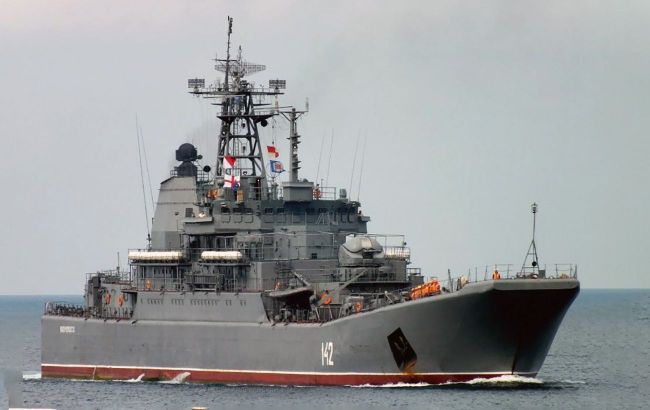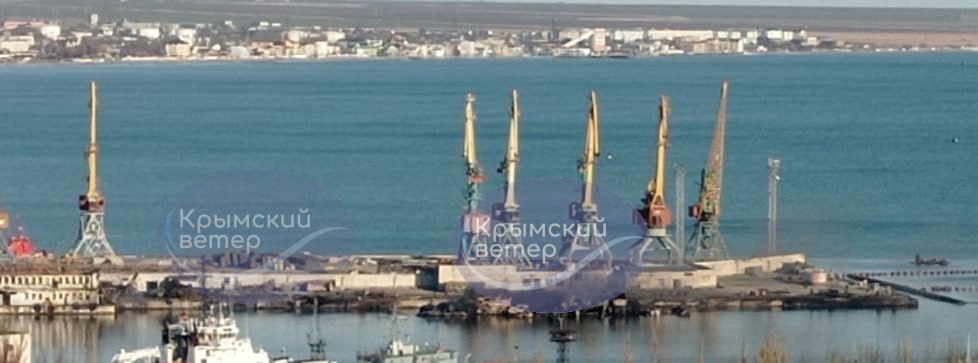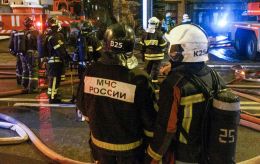Novocherkassk transforms into 'submarine': Ukraine's Russian Fleet depleting strategy, and count of ships resting at bottom
 Russian large landing ship Novocherkassk (Photo: Russian media)
Russian large landing ship Novocherkassk (Photo: Russian media)
The Ukrainian Air Force struck the Russian large landing ship Novocherkassk in the area near the occupied Feodosia. This became another blow to the fleet of the aggressor country, which had previously been forced to move some of its warships away from Crimea.
More details on the strikes on the ships and how the Ukrainian forces weakened the Russian fleet in the Black Sea can be found in the material by RBC-Ukraine.
The material was prepared using data from the Telegram channel Crimean Wind, statements by the Commander of the Air Force Mykola Olechuk and other military speakers, information from Wikipedia, conclusions from OSINT analysts, and comments from expert Volodymyr Zablotskyi.
The destruction of the Novocherkassk: What is known?
Overnight on December 26 in Feodosia, explosions were reported along with activity from Russian publications regarding anti-aircraft defense. As a result, a significant fire erupted in the port area. The occupying authorities confirmed the attack and reported at least one fatality.
Footage of the explosive incident has also surfaced online.
Commander of the Air Force, Mykola Olechuk, declared the destruction of the ship, emphasizing the continuous reduction of the Russian fleet.
"This time, following the Russian Black Sea Fleet's flagship, the Moskva cruiser, a large landing ship, the Novocherkassk, was hit," he noted.
Southern Defense Forces spokesperson Natalia Humeniuk stated that the strike on the Novocherkassk caused a sustained detonation of ammunition. Assessing the scale of the explosions, she suggested that the detonation might not have been merely due to the ship's fuel or onboard ammunition but could have resulted from the ship being fully loaded with munitions.
Given the proximity of everything in the Feodosia port, there is a possibility that another vessel was damaged, but this information requires confirmation.
According to the Russian Ministry of Defense, the attack involved airstrikes using guided missiles. Allegedly, the Novocherkassk suffered damage, but no destruction was reported. It's worth noting that this is customary wording by adversaries to mitigate the impact of successful Ukrainian actions. To offset the news of losing the landing ship, the occupiers fabricated reports of allegedly destroying two Su-24 fighter jets 125 kilometers northeast of Mykolaiv.
Head of the Presidential Office, Andriy Yermak, responding to the strike on the Novocherkassk, declared that there would be no Russian Black Sea Fleet in Crimea because Crimea belongs to Ukraine. President Volodymyr Zelenskyy thanked the Air Force for effectively "adding one more vessel to the Russian Black Sea submarine fleet."
"There will be no peaceful place for the occupiers in Ukraine," he added at the end of another Staff meeting.
The official account of the Ministry of Defense of Ukraine made a jest by posting, "Ukrainian warriors modified the russian Novocherkassk large landing ship—now it's a submarine."
Ukrainian warriors modified the russian Novocherkassk large landing ship—now it's a submarine. pic.twitter.com/CMoQDAuzdR
— Defense of Ukraine (@DefenceU) December 26, 2023
The Telegram public channel Crimean Wind reported that the attacked Novocherkassk was transporting Iranian combat drones - Shaheds. The Center for Strategic Communications and Information Security confirms that the ship was carrying drones used by Russia for strikes against Ukraine.
The version regarding Shaheds was commented on by Air Force spokesman Yurii Ihnat. He neither confirmed nor refuted this information, stating that those who possess such information should disclose it. Simultaneously, he acknowledged that the massive detonation indicated the presence of a powerful ammunition stock. He added that the operation was planned by the Armed Forces and other structures.
Military naval expert and Defense Express observer Volodymyr Zablotskyi believes that intelligence recorded the moment when the Dock Landing Ship (LSD) arrived in Feodosia loaded with ammunition, and the Air Force caught it by striking with at least one missile directly at the ship.
"They destroyed it completely: the cargo exploded, the fuel exploded, everything went off with the crew. Regarding the Shaheds, why not? If landing ships transport ammunition, and Shaheds are launched from Cape Tarkhankut, it's quite possible," he tells RBC-Ukraine.
However, the ship itself did not arrive from Iran. The Russians deliver Shaheds to Astrakhan, then further by rail. Since the opponent is constrained in logistics due to the Crimean Bridge, a portion of the drones is delivered precisely via the LSD.
The destruction of the Novocherkassk is confirmed by OSINT analysts. According to their data, the ship was sunk in Feodosia due to a missile strike. Analyst Oliver Alexander writes that there is almost nothing left of the LSD; the entire front part went underwater and, most likely, is completely destroyed. It is unlikely the vessel is salvageable. Even Russian "Z-war correspondents" acknowledge the ship's loss.
At present, it is precisely unknown which missiles were used against the Novocherkassk. Yurii Ihnat reminds that thanks to partners, Ukraine acquired long-range aviation missiles like Storm Shadow and SCALP; no other types are available. The type of missiles used in a night attack, along with their total quantity in possession, is traditionally not commented on by the Ukrainian side.
The Novocherkassk is not the only one. Which other ships Ukraine targeted
Before the full-scale invasion, Russia moved an additional six large landing ships from the Northern and Baltic fleets to the Black Sea. Consequently, the grouping of such vessels was increased to 13 units.
The opponent planned to use the LSDs in landing operations to seize the Odesa and Mykolaiv regions. However, they faced stern opposition from Ukraine's coastal defense. Presently, the landing ships are used for logistical purposes: transferring personnel, military equipment, and ammunition between Russian ports and temporarily occupied territories.
The Ukrainian defense forces inflicted noticeable losses on Russian LSDs.
"Saratov was sunk on March 24, 2022, near Berdyansk by a Tochka-U missile. At that time, Caezar Kunikov and Novocherkassk were also damaged," notes Volodymyr Zablotskyi.
Regarding Caezar Kunikov, information about the death of Captain Oleksandr Chyrva is known. In August 2023, kamikaze drones attacked the LSD Olenegorsky Gornyak in the Novorossiysk bay, and in September, a Storm Shadow missile struck the LSD Minsk due to a strike on the docks of the Sevmorzavod.

Photo: Consequences of the strike on the LSD Minsk in Sevastopol, September 13, 2023 (t.me/Crimeanwind)
Twenty-one months later, Ukrainian aviation concluded the matter of the Novocherkassk. Photos of the ruined ship in Feodosia have emerged online.

Photo: LSD Novocherkassk after the strike on the night of December 26 (t.me/VentdeCrimee)

